Fairford
Fairford is a market town in Gloucestershire, England. The town lies in the Cotswold hills on the River Coln, 6 miles (9.7 km) east of Cirencester, 4 miles (6.4 km) west of Lechlade and 9 miles (14 km) north of Swindon. Nearby are RAF Fairford and the Cotswold Water Park.
| Fairford | |
|---|---|
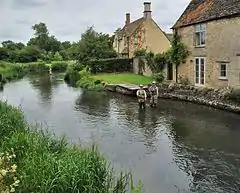 River Coln, Fairford | |
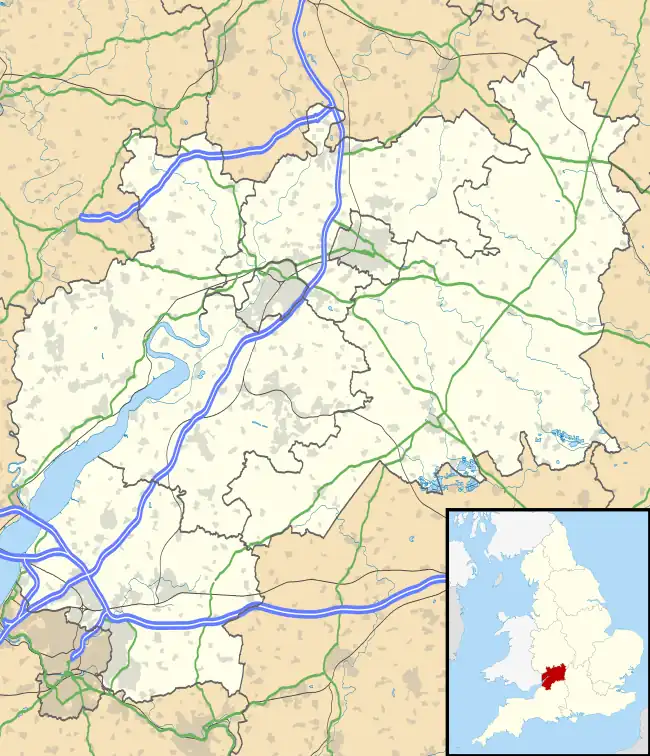 Fairford Location within Gloucestershire | |
| Population | 3,236 (2011 census)[1] |
| OS grid reference | SP149010 |
| District | |
| Shire county | |
| Region | |
| Country | England |
| Sovereign state | United Kingdom |
| Post town | Fairford |
| Postcode district | GL7 |
| Dialling code | 01285 |
| Police | Gloucestershire |
| Fire | Gloucestershire |
| Ambulance | South Western |
| UK Parliament | |
| Website | Welcome to Fairford Town Council |
History
Iron Ages
There was a major roundhouse settlement in Horcott (on the south side of the town),[2] and the Welsh Way, which passed through Fairford, was used during this period as a trade route.
Middle Ages
Evidence of settlement in Fairford dates back to the 9th century and it received a royal market grant in the 12th century.[3] An estate in Fairford, which seemingly belonging to Gloucester Abbey, was bequeathed to Burgred of Mercia in the mid 9th century.[3] At the time of the Norman conquest, Brictric, a large landowner in the West Country, held a manor in Fairford.[3] Matilda of Flanders came to own the land which became property of the Crown.[3] In 1100, Robert Fitzhamon, the first Norman feudal baron of Gloucester, is recorded as owning the land which would be passed down to subsequent barons of Gloucester for the next 200 years,[3] along with the manor of Tewkesbury.
In the Domesday Book, Fairford was listed as Fareforde.[4] In 1066 there were three mills in the town, one of which was still used in the wool trade by the 13th century. The mill that survives today was built in the 17th century.[3]
Both Edward I and Henry VIII were royal visitors to the town in 1276 and 1520 respectively.[3]
Fairford is recorded as having a prison in 1248. Hundred courts were held by the lord of the manor and borough.[3]
By the 15th century the land of Fairford was managed by wool merchants John Twynyho and John Tame after George Plantagenet, Duke of Clarence was forced to give up his lands after being tried for treason.[3]
17th and 18th century
In 1608, the inhabitants of Fairford were mostly agricultural labourers or artisans.[5]
Fairford Park, to the north of the town, was made part of the manor house grounds, built by Andrew Barker in the 1660s.[3][6] It would later be turned into a deer park by James Lambe, with an obelisk built to mark the edge of the grounds.[3][7] The park remained in the Barker family until it was sold to Earnest Cook in 1945.
In 1755, seven innkeepers were licensed in Fairford. The first recording of an inn had been in 1419 and this grew over the centuries owing to Fairford's location as a connecting town between larger metropolitan areas. Stagecoach routes often called at Fairford before travelling on to Gloucester, Cirencester, Bristol, Oxford and London.[3]
19th and 20th century
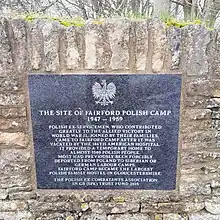
During the Swing Riots in the 1830s, farming machinery being manufactured in Fairford was destroyed by protestors.[3] By this time there were pounds in the town as well as a village lock-up that had been around since at least 1809.[3]
RAF Fairford was constructed in 1944 as a joint British and American base.[8]
From 1947-1959, Fairford housed 1,200 Poles in The Displaced Persons Camp who had been displaced due to the Second World War.[9] The site had originally been an American Air Force hospital that was built during the war. The buildings were then repurposed for the camp before being demolished in 1977.[3]
Iraq War
In March 2003 'Flowers to Fairford' was held as a protest against the use of RAF Fairford as the base for the 14 B-52 bombers aircraft which were used to bomb Iraq as part of Operation Desert Storm. Several thousand people attended and there was a large police presence, but the event passed off peacefully.[10] A coach load of people intending to protest was stopped in Lechlade under Section 44 of the Terrorism Act 2000 and searched by police and sent back to London.[11][12] Ninety of the detained demonstrators formed Fairford Coach Action and sought legal recourse against Gloucestershire constabulary.[13] The group stated that:
"On 22 March 2003, the police used surprisingly extreme tactics to prevent more than 120 activists from reaching [the] legally sanctioned anti-war demonstration in Fairford, (Gloucestershire, UK). The demonstration outside a US Airforce Base in Fairford was well attended with estimates of up to 5,000 activists attending. Among the scheduled speakers on the day were writer George Monbiot and Caroline Lucas (MEP). The people who police prevented from attending were a diverse group with a broad range of affiliations. The main thing that they had in common was the desire to travel from London by coach and the intention of joining the legal protest in Fairford. Two of the four main scheduled speakers for the Fairford demonstration were travelling on these coaches from London. After the coaches had travelled two and a half hours from London, the coaches were stopped by police just miles from the demonstration. Using section 60 powers (of the Public Order and Criminal Justice Act 1994) police searched the coaches for weapons for one and a half hours. The passengers cooperated with this search, and they were invited to reboard the coaches when the search concluded. No arrests were made and no items found. After all the passengers boarded, the coaches were escorted immediately back to London under a continuous 9–12 vehicle police escort."
In 2013, after appeal, Gloucestershire police's actions were found to be unlawful, and included breaching "protesters' rights to freedom of expression and freedom of peaceful assembly."[14] Some of the demonstrators involved were awarded upwards of £4,000 in compensation by a judge after taking their claim to court.[15]
Flooding
In July 2007 Fairford suffered unseasonably high rainfall which led to major flooding of 64 homes on Milton Street and London Street as well as in some other surrounding areas. This meant that many of the annual events had to be cancelled.
Archaeological find
In 2013, a female skeleton was found in the River Coln and was later discovered to be of Sub-Saharan origin. The remains were estimated to be around 1000 years old and it is thought that the woman was around 18-24 when she died.[16][17]
Churches
St Mary's Church
The Church of England parish church of Saint Mary is renowned for its complete set of medieval stained glass, stone carvings and misericords. Rebuilt in the early 1490s by the wool merchant John Tame (d.1500), the church is an example of late Perpendicular Gothic architecture that is characterised by slim stone window mullions and light but strong buttresses. The style enabled larger windows than previously, allowing much more light into the building. Grade 1 listed by English Heritage, its structure and details remains unaltered since built.[18]
Stained glass, St Mary's Church
St. Mary's is of national historical and architectural importance because it houses the most complete set of mediaeval stained glass windows in the country, attributed to Barnard Flower. The glass survived the Reformation when many images in English churches were destroyed. In 1642, during the Civil War, they narrowly avoided destruction[19] when the Roundhead army was marching on the nearby town of Cirencester.
Some of the panes were damaged during a storm in November 1703 and those were repaired and modified or replaced. A conservation and restoration programme began in 1988 and finished in 2010. Clear glass now protects the old glass.[20]
Churchyard, St Mary's Church
The churchyard includes a stone memorial to Tiddles, the church cat who fell off the church roof. There is also a stone grotesque to commemorate a young boy who climbed up the walls of the church and jumped, falling to his death. The churchyard contains eight Commonwealth war graves; three British Army soldiers, a Royal Navy seaman and a Royal Air Force airman of World War I and two British soldiers and a Home Guardsman of World War II.[21]
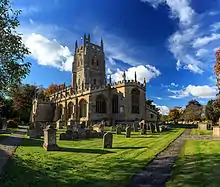 Parish church of St. Mary (consecrated 1497)
Parish church of St. Mary (consecrated 1497)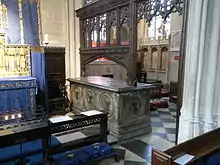 The tomb, in St. Mary's Church, of John Tame and his wife Alice Twynyho.[22]
The tomb, in St. Mary's Church, of John Tame and his wife Alice Twynyho.[22] Monumental brass for Edward I Tame in the north wall of the Lady chapel.
Monumental brass for Edward I Tame in the north wall of the Lady chapel.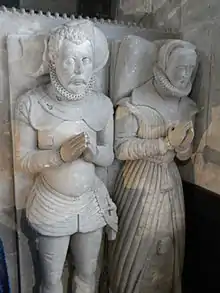
St Thomas' of Canterbury
Fairford has a 19th-century Catholic church of St Thomas of Canterbury. Following the closure of the recusant chapel at Hatherop Castle in 1844, a church was built at Horcott the following year at a cost of £700. The first Mass was celebrated in 1845, five years before the Restoration of the Hierarchy in England and before the creation of the Roman Catholic Diocese of Clifton. The stained glass window behind the altar depicts St. Thomas of Canterbury in the centre panel, showing the date 1845. The adjoining Presbytery was built 20 years later to designs by Benjamin Bucknall,[24] the architect of Woodchester Mansion. The church contains an organ by Hill and stained glass by William Wailes, Hardman and Geoffrey Robinson. The two windows in the porch were added to commemorate the 150th anniversary of the first Mass. The left window depicts the crest of the de Mauley family; that on the right depicts the Eucharist.
Fairford United Church
In 1981 a group of local Methodists approached the local Congregational Church to use the chapel for their services as there was no Methodist Church in Fairford. They were officially united into one congregation in 1986 and the present church follows the traditions of both the Methodist Church and the Congregational Federation.
The churches in and around Fairford are represented by the organisation Churches Together Around Fairford (CTAF) which has meetings and organises services of unity.
Governance
Fairford was part of the Cirencester Rural District until the Local Government Act 1972, when it became part of the Cotswold District.[3]
Fairford has a Parish Council with 13 members. The mayor is James Nicholls.
After a boundary review implemented for the 2015 local elections, Fairford was split into two District Council electoral wards called Fairford North Ward (single member) and Lechlade, Kempsford and Fairford South Ward (two member). On Cotswold District Council Fairford North Ward is represented by Liberal Democrat Andrew Doherty and Lechlade, Kempsford and Fairford South Ward is as of May 2023 represented by Liberal Democrats Councillors Clare Muir and Helene Mansilla.
As of 2021, the town is represented on Gloucestershire County Council by Conservative Councillor Dom Morris who represents the Fairford and Lechlade on Thames Division.
The ward population at the 2011 census was 4,031.[25]
2023 Cotswold district Council Election Results
| Party | Candidate | Votes | % | ±% | |
|---|---|---|---|---|---|
| Liberal Democrats | Michael Vann | 406 | 51.5 | -17.7 | |
| Conservative | Tom Dutton | 316 | 40.1 | +9.8 | |
| Heritage | James Nicholls | 67 | 8.5 | N/A | |
| Majority | 90 | 11.4 | |||
| Turnout | 789 | ||||
| Liberal Democrats hold | Swing | ||||
| Party | Candidate | Votes | % | ±% | |
|---|---|---|---|---|---|
| Liberal Democrats | Clare Muir | 1,150 | 56.5 | +26.2 | |
| Liberal Democrats | Helene Mansilla | 976 | 48.0 | N/A | |
| Conservative | Stephen Andrews* | 785 | 38.6 | -13.4 | |
| Conservative | Steve Trotter* | 776 | 38.2 | -13.6 | |
| Labour | Esme Barlow Hall | 131 | 6.4 | N/A | |
| Labour | Trevor Smith | 114 | 5.6 | -9.1 | |
| Majority | 191 | ||||
| Turnout | 2034 | 9.4 | |||
| Liberal Democrats gain from Conservative | |||||
| Liberal Democrats gain from Conservative | |||||
2017 Cotswold district Council by-election results
Fairford North Ward
| Party | Candidate | Votes | % | ±% | |
|---|---|---|---|---|---|
| Liberal Democrats | Andrew Doherty | 610 | 68.1 | +40.2 | |
| Conservative | Dominic Morris | 270 | 30.1 | -20.9 | |
| Green | Xanthe Messenger | 15 | 1.8 | +1.8 | |
| Majority | 270 | 38.0 | |||
| Turnout | 897 | 46.57 | |||
| Liberal Democrats gain from Conservative | Swing | 30.6% | |||
2021 Gloucestershire County Council election results
| Party | Candidate | Votes | % | ±% | |
|---|---|---|---|---|---|
| Conservative | Dom Morris | 2,326 | 59 | +4 | |
| Liberal Democrats | Tony Dale | 1,344 | 34 | +2 | |
| Labour | Sharon Aldrick | 261 | 7 | +1 | |
| Majority | 982 | 25 | +2 | ||
| Turnout | 3,931 | 45.20 | +5.40 | ||
| Conservative hold | Swing | ||||
Education
The town's secondary school is Farmor's School, an 11-18 co-educational academy. The school was judged to be of outstanding standard, having achieved Grade 1 in its Ofsted inspection in 2010.[26] After becoming an academy it achieved lower grades from the board over the years: "Good", "Requires Improvement" and "Good" again in 2013, 2017 and 2021 respectively.[27]
There is also a primary school (Fairford Primary),[28] and a playgroup. Coln House School was a 9-16, residential/day, state special school. After being put into special measures following a 2016 Ofsted report, the school closed in March 2017.[29] Built in 1822 by Alexander Iles as a private asylum called The Retreat, it closed in 1944 before becoming a school in 1949.[30]
Transport
Fairford was formerly linked to Oxford by the Witney Railway and its extension the East Gloucestershire Railway. The route was active between 1873-1962.[3] There have been reports that part of the old track could be cleared of accumulated mountains of detritus and overgrown trees to be re-opened as a cycle path. There is a bus service to Cirencester and Lechlade, from where travellers can transfer to another bus and travel onwards to Swindon.
Media
Regional local news and television programmes is provided by BBC South and ITV Meridian. Television signals are received from the Oxford TV transmitter. [31]
Local radio stations are BBC Radio Wiltshire, Heart West, Greatest Hits Radio South West, Cotswolds Radio, community based radio station [32] and Air Tattoo Live, a RSL station which broadcast coverage during the Royal International Air Tattoo.
The town is served by the weekly local newspaper, Wilts and Gloucestershire Standard. [33]
Events
Air Tattoo
For three days every year RAF Fairford hosts one of the world's largest military air show – the Royal International Air Tattoo. The event brings a boost to the economy of the town and surrounding areas.
Ploughing Championship
The Fairford, Faringdon, Filkins and Burford Championship and Country Show held every year since 1948.[34]
Steam Rally
The Ernest Cook Trust used to host the annual Fairford Steam Rally and Show. The Show closed in 2015 after running for 46 years.[35]
Sport and leisure
Fairford has a non-league football team Fairford Town F.C. who play and train at Cinder Lane. Fairford have their own rugby team FRFC, playing in green and black strip. The town also has the Walnut Tree Field: a large playing field and park, a cricket club (dating back to the early 1900s),[3] a bowling, sailing and water skiing club.[36][37][38] Fairford had a leisure centre until 2019 which had been managed by Farmor's School since 2013.[39]
Fairford also has a youth football club, based at Horcott Road which caters for children between the ages of 5 and 15 years old. The club, established in 1976, is a FA Chartered Club, run by volunteers for the benefit of local children from Fairford and surrounding villages. Teams from U8 and above play in the North Wiltshire Youth Football Leagues.
Literature
The Secret Diary of Sarah Thomas, 1860 – 1865, is a published journal by a Victorian diarist living in Fairford. It features local landmarks.[40]
Notable residents
- Kenton Cool - (1973 – ) Mountaineer
- Paul Cornell - (1967 – ) Writer
- Frank Cadogan Cowper - (1877 – 1958) Artist
- Sharron Davies - (1962 – ) Competitive swimmer and sports presenter
- Mary Bathurst Deane - (1843 – 1940) Novelist
- Barbara Dockar Drysdale - (1912 – 1999) Psychotherapist
- Wills Hill, 1st Marquess of Downshire - (1718 – 1793) Politician
- Sir Arthr Hirtzel - (1870 – 1937) Civil servant
- John Keble - (1792 – 1866) Anglican priest and poet
- Noël Leslie, Countess of Rothes - (1878 – 1956) Socialite, who survived the Titanic disaster
- Mike Winters (1926 – 2013) Comedian
References
- "Parish population 2011". Archived from the original on 2 April 2015. Retrieved 23 March 2015.
- Biddulph, Edward. "Oxford Archaeology - Latest news". oxfordarchaeology.com. Retrieved 22 April 2023.
- Herbet, N. M. (1981). "'Fairford', in A History of the County of Gloucester: Volume 7". www.british-history.ac.uk. Retrieved 22 July 2021.
- "The Domesday Book Online - Gloucestershire A-F". www.domesdaybook.co.uk.
- Warmington, Andrew (1989). "FROGS, TOADS AND THE RESTORATION IN A GLOUCESTERSHIRE VILLAGE". Midland History. 14 (1): 30–42. doi:10.1179/mdh.1989.14.1.30. ISSN 0047-729X.
- "Andrew Barker ca.1630-1700 - Book Owners Online". bookowners.online. Retrieved 8 January 2023.
- The Gentleman's House in the British Atlantic World 1680-1780. doi:10.1057/9781137378385.
- Morgan, William (13 December 2022). "US Air Force moving HQ to RAF Fairford". GloucestershireLive. Retrieved 8 January 2023.
- "Memorial marks 50th anniversary of Polish camp". Wilts and Gloucestershire Standard. Retrieved 8 January 2023.
- "Flowers to Fairford - 22 March 2003". www.fairford.org. Archived from the original on 29 July 2012.
- "Telegraph | Opinion | The police must end their abuse of anti-terror legislation". 31 December 2005. Archived from the original on 31 December 2005. Retrieved 20 April 2023.
- Dent, Jackie (14 October 2004). "'Coach-napped' activists protest outside court". The Guardian. ISSN 0261-3077. Retrieved 16 April 2023.
- Staff (23 October 2006). "Anti-war protesters' rights breached, court told". The Guardian. ISSN 0261-3077. Retrieved 16 April 2023.
- "RAF Fairford protesters win legal battle against police". BBC News. 8 February 2013.
- Bowcott, Owen; correspondent, legal affairs (8 February 2013). "Iraq war activists to get £4,000 compensation over 2003 protest". The Guardian. ISSN 0261-3077. Retrieved 16 April 2023.
- Gover, Dominic (18 September 2013). "The First Black Briton? 1,000 Year Old Skeleton of African Woman Discovered by Schoolboys in Gloucestershire River". International Business Times UK. Retrieved 17 April 2023.
- "Schoolboys amazed that skeleton is 1,000 year old African woman". Wilts and Gloucestershire Standard. Retrieved 17 April 2023.
- Historic England. "Church of St Mary, Fairford (1089998)". National Heritage List for England. Retrieved 12 July 2011.
- Don Cobbett (8 August 2011). "Fairford Town History". Fairford & District U3A. Retrieved 6 December 2018.
- Andrew Russel (8 June 2012). "The History of St Mary's Church". St. Mary's Church Fairford. Retrieved 6 December 2018.
- http://www.cwgc.org/find-a-cemetery/cemetery/38552/FAIRFORD%20(ST.%20MARY)%20CHURCHYARD CWGC Cemetery Report, details from casualty record.
- Keble, Rev. Edward, St. Mary's Church, Fairford. 6th. ed., Much Wenlock, 2010, p.27
- MacLean, Sir John (ed.), Visitation of Gloucestershire 1623, London, 1885, p.260 Tame, p.51 Dennis
- "St Thomas Catholic Church Fairford". www.stthomasparish.plus.com.
- "Ward population 2011". Retrieved 23 March 2015.
- "OFSTED report" (PDF). Archived from the original (PDF) on 14 July 2010.
- Ofsted Communications Team (25 September 2021). "Find an inspection report and registered childcare". reports.ofsted.gov.uk. Retrieved 16 December 2022.
- "Fairford C of E Primary School".
- "Establishment Coln House School". Gov.uk. Retrieved 29 June 2021.
- "Coln House School". Historic England. Retrieved 29 June 2021.
- "Full Freeview on the Oxford (Oxfordshire, England) transmitter". UK Free TV. 1 May 2004. Retrieved 25 September 2023.
- "Cotswolds Radio". Retrieved 26 September 2023.
- "Wilts and Gloucestershire Standard". British Papers. 25 October 2013. Retrieved 26 September 2023.
- FFF&B. "F.F.F.& B Ploughing Match". F.F.F.& B Ploughing Match. Retrieved 18 April 2023.
- "Breaking: Fairford Steam Show to close after running for 46 years".
- "Walnut Tree Field - playing field & park". 18 August 2018.
- "Fairford CC".
- "Leisure Centre". 16 December 2000.
- "Row over report looking into closure of Tetbury and Fairford leisure centres". Wilts and Gloucestershire Standard. Retrieved 8 January 2023.
- "The secret diary of Sarah Thomas : 1860-1865 | WorldCat.org". www.worldcat.org.
Further reading
- Verey, David (1970). The Buildings of England: Gloucestershire: The Cotswolds. Harmondsworth: Penguin Books. pp. 243–250. ISBN 0-14-071040-X.
- Farmer, Oscar G. Fairford Church and its Stained Glass Windows 7th ed. 1962 (presumably self-published, printed by Harding and Curtis Ltd, Somerset Hall, Bath)
- Bigland, Ralph (1791) An Account of the Parish of Fairford; ed. by Richard Bigland
External links
- Fairford community website
- Fairford Town CCouncil website
- Fairford United Church
- Fairford Youth FC
- St. Mary's Church in Fairford – Sacred Destinations
- St Thomas' Catholic Church website Includes history, pictures and details of services.
- BBC archive film of Fairford from 1986
- Local Online website for the Lechlade and Fairford community